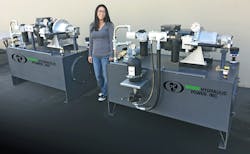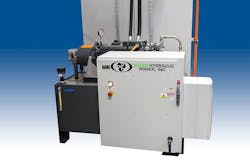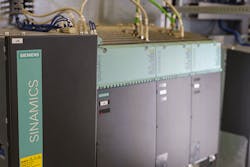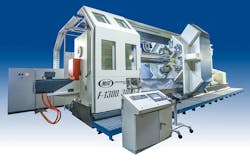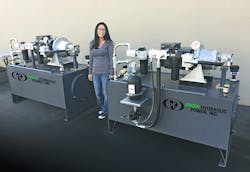A Design Story: Green Hydraulic Power for New and Retrofit Technology
MJC Engineering, a custom machine tool builder in Huntington Beach, Calif., specializes in metal-spinning machines for such applications as sheet spinning, flow forming, wheel spinning, and rotary forging. MJC is a major supplier to the automotive, aerospace, and wheel industries. It recently announced the development of a new hydraulic power system, termed Green Hydraulic Power, in conjunction with Siemens.
The Need for Better Hydraulic Power
The Green Hydraulic Power unit, designed by MJC Engineering, provides power on demand. Documented energy savings of up to 70% have been reported, earning users energy credits from their home states.
About three years ago, the president at MJC, Carl Lorentzen, began investigating the configuration of the hydraulic units used on his company’s machinery. Lorentzen had interest in servo-pump technology, having read about its application in other industrial uses such as injection-molding machines, extruders, stamping presses, offshore oil rig assemblies, cranes, lifts, and other materials-handling equipment.
Lorentzen says, “We had looked at a variety of ways to improve the energy efficiency of our machines. Being a California company, there are substantial incentives offered here for documented energy savings in machine building and operations. Plus, I felt it was simply the right course of action to do our part in protecting natural resources.”
He also cited a recent incident in which MJC changed insurance carriers and, as part of the company safety audit, sound levels were tested and the hydraulic power units became a concern. Lastly, as MJC sells its machines to premier OEMs around the world, issues involving big data capture, as well as IIoT and Industry 4.0 integration, were surfacing from customers.
MJC began serious investigation into the application of servo-pump technology to replace the constant motor operation on the main hydraulic unit of the machines, in a concerted effort to reduce energy consumption, noise and, owing to the smaller hydraulic reservoirs needed, the machine footprint. These definable upsides for MJC machine design and the company’s marketing of its equipment caused considerable excitement for Lorentzen, who notes, “We are fortunate to have on our staff an amazing group of electrical, hydraulic, controls, and mechanical engineering talents. All these engineers had the same reaction I did, and we began to rethink our hydraulic power units from the ground up.”
Partnership with Siemens
SINAMICS drives from Siemens control the operation of the entire unit, with Safety Integrated functionality.
MJC turned to Siemens, its longtime automation supplier, to help design a new hydraulic power unit. A team led by Chris Britton, the Siemens sales manager for the region, assisted with various application engineering studies, and energy and controls testing to affect the optimum design, all while working in concert with the MJC team.
Britton explains, “Siemens and MJC have been frequent project partners for some time, so this marriage of technologies was even easier to accomplish. We offer our SINAMICS servo-pump technology to customers, utilizing various pumps with our motors and drives.”
From the OEM perspective, MJC benefitted from the conceptualization, engineering, and commissioning tools offered by Siemens in the build-up of the GHP units. Sizer, a driver design tool for Siemens Drives, orchestrated the integrated data across the entire platform of drives technology. This enabled the MJC engineering team to match the most suitable products to the specific requirements of the end-user applications, with a drastic reduction in the engineering time on subsequent unit designs. M-CAD likewise made it possible to import all motor specifications to match the requirements of each job.
For the end user, the Siemens TIA Portal provided faster commissioning, thus increasing productivity and facilitating comprehensive data capture. This, in turn, benefits both operations/maintenance personnel and the integration of the data into a “digital factory” mode, as the system’s condition monitoring and diagnostics can reside in the cloud or otherwise be networked to a controls communication stream. Depending on the drives technology selected, it is also possible for end users to perform online configuration of the drives via their web server.
Onset of Green Hydraulic Power
Shown is a typical spin-forming machine from MJC. Use of Green Hydraulic Power onboard improves energy use, and reduces noise and footprint.
With the help of Siemens, the Green Hydraulic Power unit (GHP) began to take shape. This system provides higher machine yield, reduces noise emissions by 20 dBA, generates less heat, produces a shorter cycle time on various machine types, and involves less oil volume—all resulting in a system that saves up to 70% in energy costs to reduce the user’s carbon footprint, according to the manufacturer. At FABTECH 2017, the company offered the unit for OEM integration by other machine builders, in addition to displaying its range of metal-forming machinery.
GHP is offered as standard on the hydraulic power units provided on MJC machine builds, and utilizes Siemens SINAMICS variable-speed servo-pump drive. High-demand hydraulic systems on many machine types significantly improve as the result of using this concept from MJC Engineering, according to Lorentzen.
“We saw that the servo pump could control pressure and flow, as they precisely convert electric energy into hydraulic power,” says Lorentzen. “In some cases, the use of control valves is partially or completely eliminated, depending on the application. We quickly realized our development could be utilized on many other types of machinery as an OEM component.” The unit could easily be adapted onto any type of heavy hydraulic piece of equipment. Subsequently, Lorentzen established Green Hydraulic Power Inc., which today functions as a free-standing enterprise.
Many applications are candidates for this new system concept, because nearly all machine tools use hydraulic power and are thus candidates for variable-speed servo-pump drive technology. Injection presses, materials-handling equipment, stamping presses, other metal-forming machines, and more can utilize Green Hydraulic Power, according to Lorentzen. “We’re finding new applications almost every day now.”
Complete payback on the GHP system is estimated at 12-24 months. The system has the extra benefit of control data output from the onboard diagnostic capability in the drive that supplies information for a predictive-maintenance protocol in an Industry 4.0 scenario. The basics of pressure, temperature, and acceleration data measurement are standard, with additional data outputs on oil level, filter condition, running efficiency, and other parameters available. The servo pump results in as much as a 70% reduction in onsite servicing, according to the manufacturer.
This new line is offered in 100-, 200-, and 300-gallon tank units rated up to 4000 psi. It comes in two styles: one with a VFD, asynchronous motor, and internal gear pump; and the other with a servo inverter, synchronous servo motor, and internal gear pump.
Success of the GHP
The Green Hydraulic Power unit comes in various kW ranges.
As MJC electrical engineer and robotics manager Jose Machuca explains, “The GHP is a complete turnkey system with I/O options to run with any PLC, to control the power utilization on virtually any type of hydraulically powered machine. We researched the variable-speed drive hydraulics for over two years to devise the optimum solution on our current standard models, which comprise 15-, 30-, 55- and 80-kW units.”
Lorentzen further notes, “Nobody is offering a closed-loop, engineered system like the GHP for integration onto a customer’s machine, with practically no impact on that machine’s design… GHP can be used as an OE component or retrofit onto an existing piece of machinery in the field. That includes practically every machine we’ve built ourselves.”
GKN Aerospace, located in Orangeburg, S.C., was the first customer for the GHP. With the GHP unit onboard its machine, GKN has experienced nearly a 70% energy-consumption savings, plus quieter operation, in a smaller footprint. Over a dozen MJC machines with GHP units have been built and installed to date (November 2017). Currently, machines with this green hydraulic unit are in operation at such industry giants as Meritor, SpaceX, Worthington, and multiple plants of GKN Aerospace. Most have been in use for six months to a year without performance issues.
Further options under development for GHP include Siemens Scalance wireless control, kW torque set point on pressure, fail-safe compatibility, custom touchscreen, and other monitoring and maintenance tools for operation and unit data transmission in an Industry 4.0 environment, over a PROFINET industrial Ethernet protocol. When equipped with the high-level Safety Integrated PLC from Siemens and other required components, the GHP is suitable for severe environments like oil rigs, chemical processing equipment, and other challenging work environment applications.
Owing to the widely varying duty cycles involved, Lorentzen states, “We can say with high certainty our customers are experiencing up to 90% energy savings, plus the quieter operation and reduced carbon footprint as additional positives. I’m certainly glad I read what others were doing with servo-pump technology, as it’s made a big and very positive impact on our company.”
